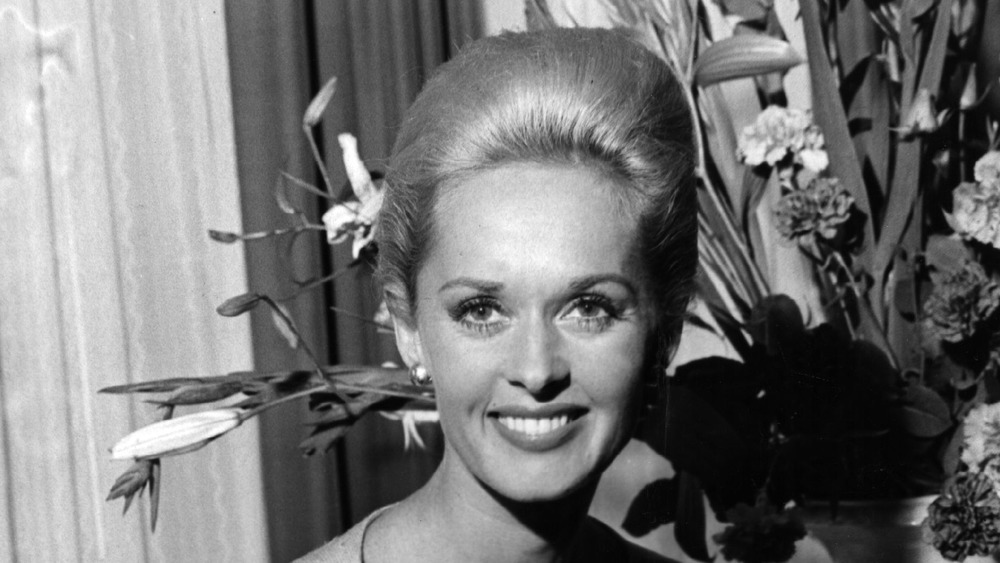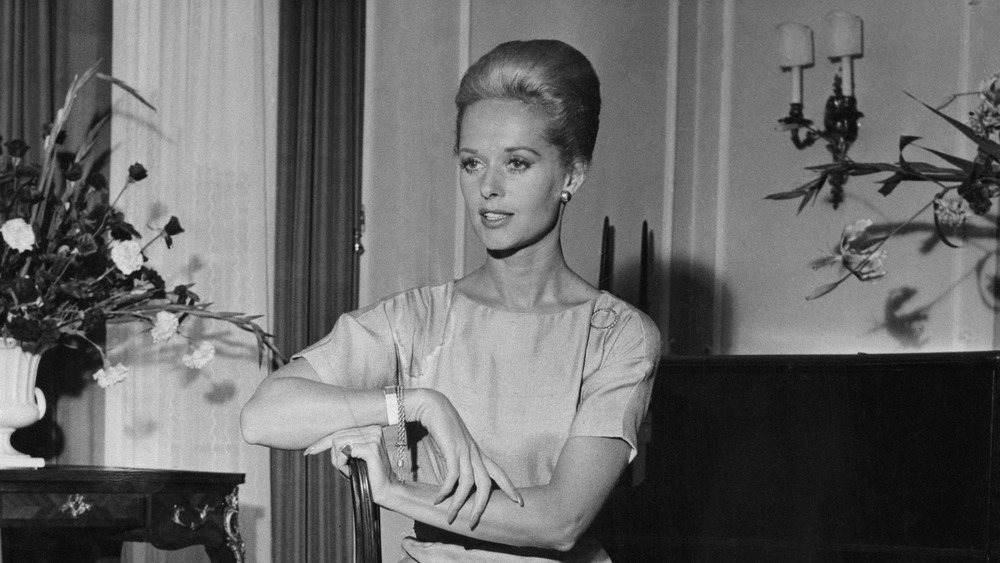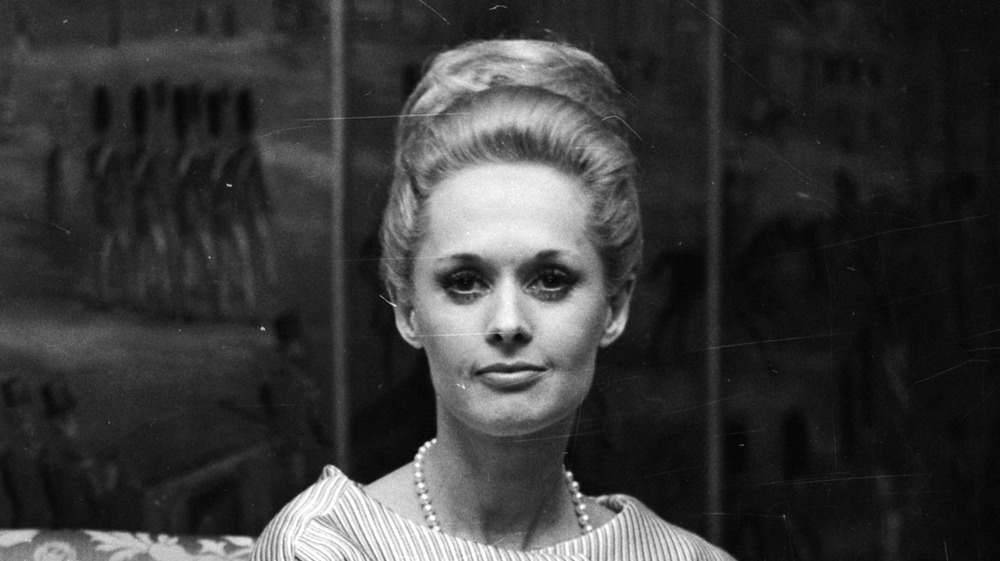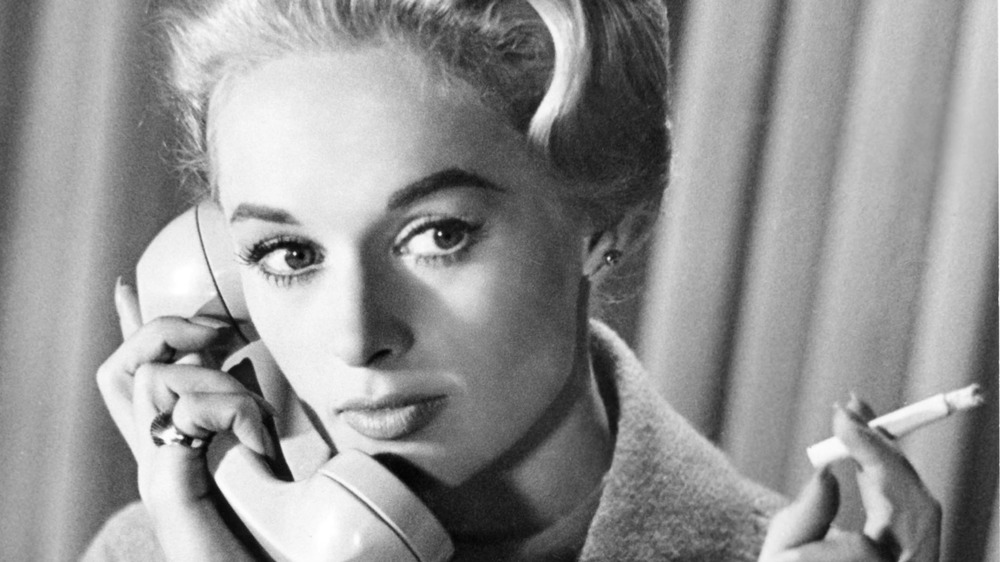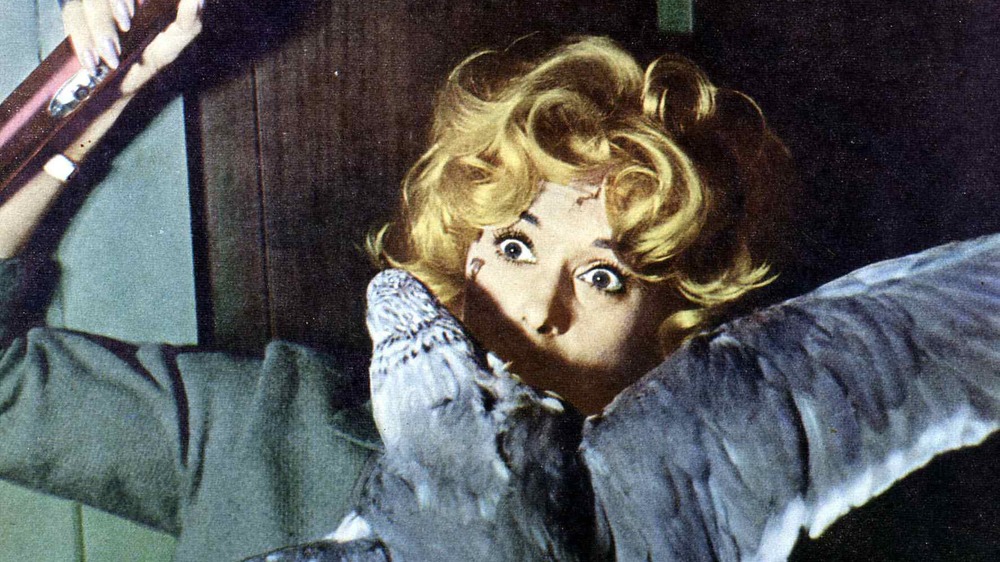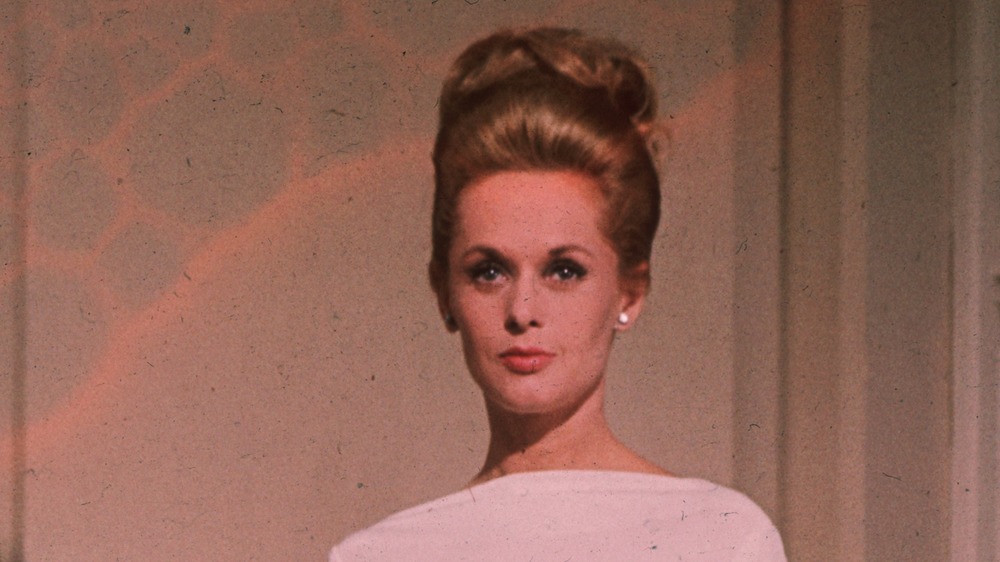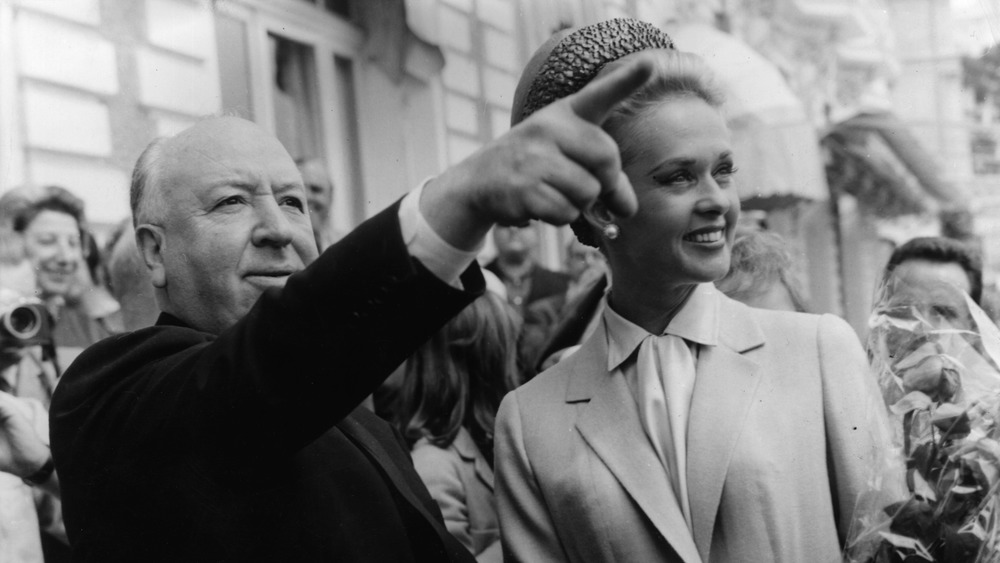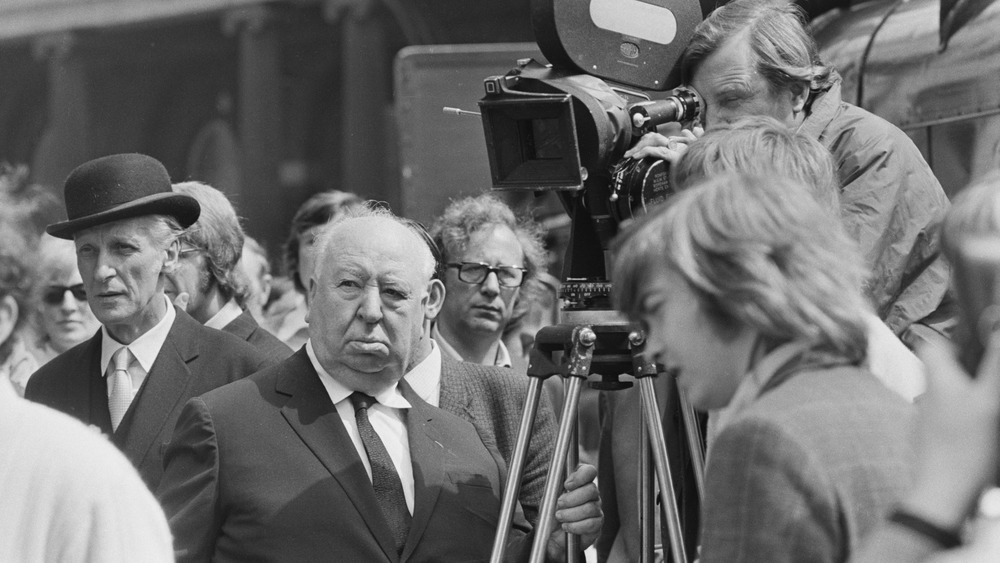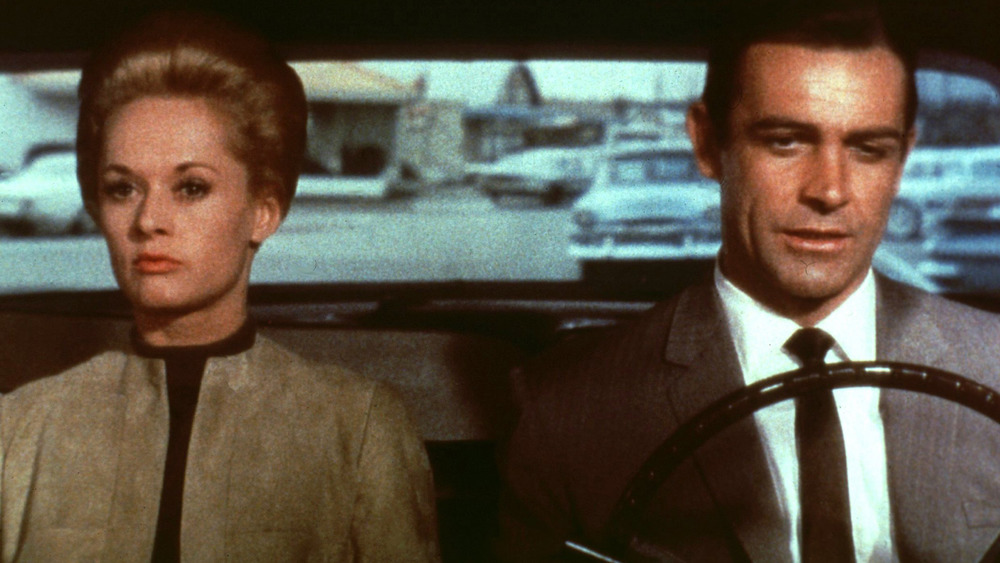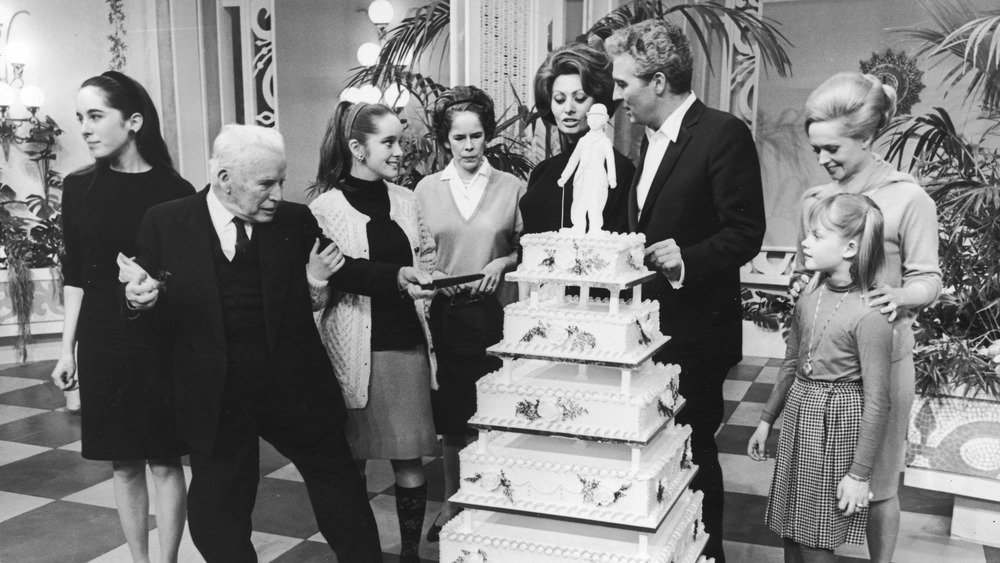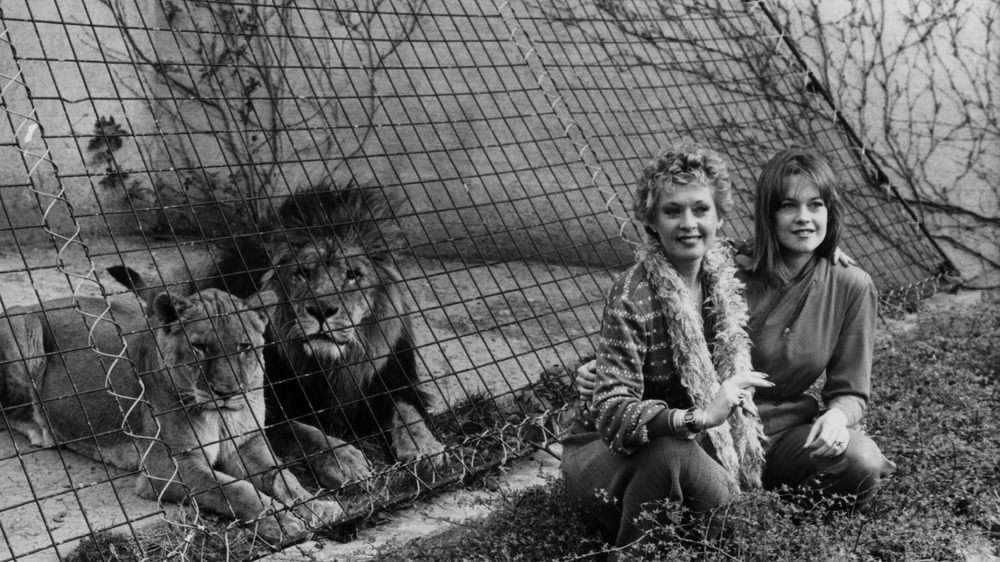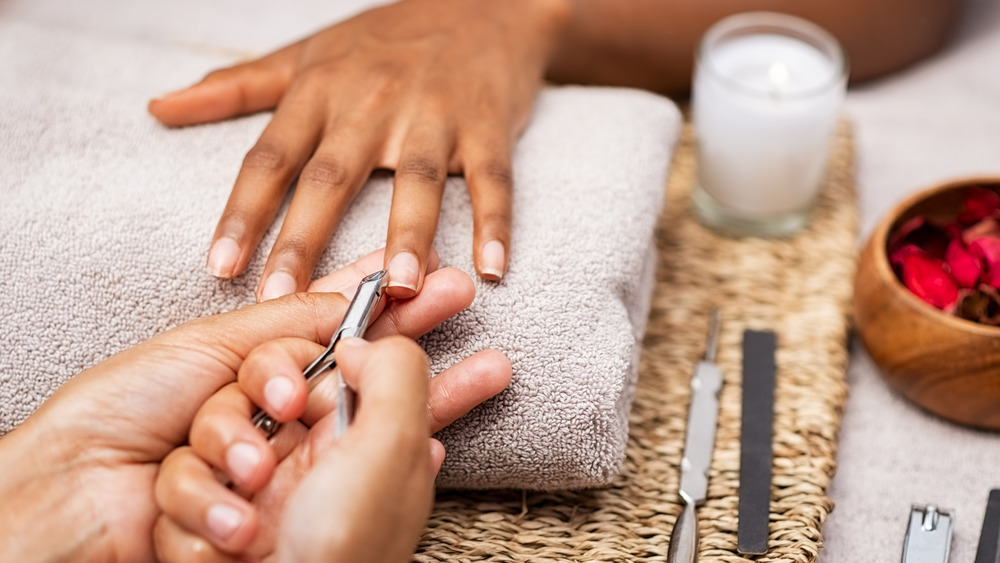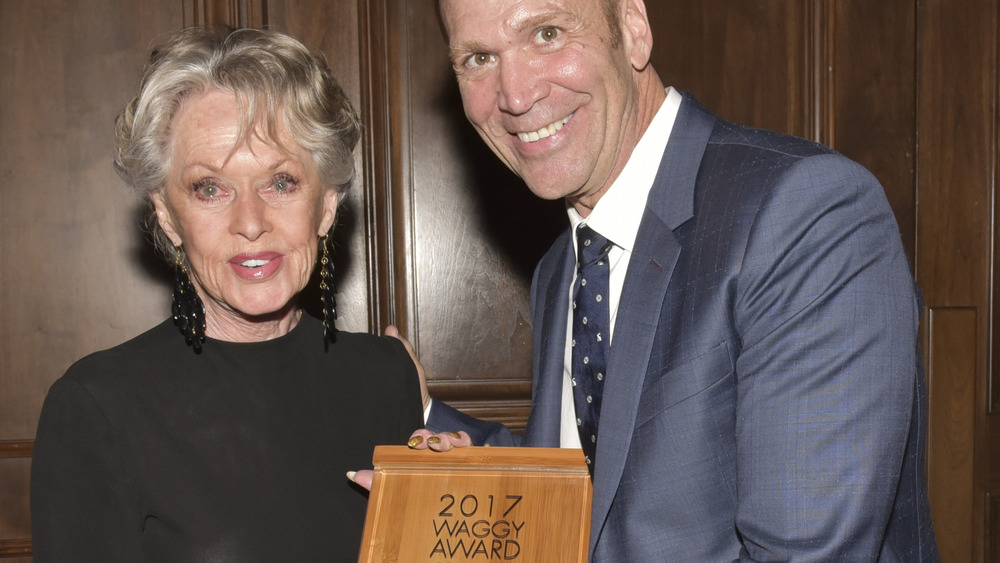The Untold Truth Of Tippi Hedren
Tippi Hedren is probably best known for her starring roles in Alfred Hitchcock's films, The Birds and Marnie. By all accounts a highly talented actress, Hedren's success in these two roles should have surely meant that she would rise to become one of Hollywood's greatest and most desired stars. Then she disappeared.
Hedren's name has also been forever linked with Hitchcock's — and not in a way that looks favorably on the director. Hedren is also most thought of as Hitchcock's "muse" — one of the original icy, cool blondes that Hitchcock typically favored. It's not Hedren's favorite way to be remembered. While she accepts that her name will be forever tied to Hitchcock on some level, she has worked hard to get away from the man who cast a dark shadow over her life many decades ago. Once she escaped him, Hedren had to forge ahead and carve out a life that was entirely her own. This is the untold truth of Tippi Hedren.
Tippi Hedren was a midwesterner before she became a California girl
Born Nathalie Kay Hedren on Jan. 19, 1930, in New Ulm, Minn., to parents of German and Scandinavian descent, Tippi Hedren was very much a midwestern girl. Her father, Bernard Hedren, owned a general store, and her mother, Dorathea, was a school teacher. Although her birth certificate states her name as "Nathalie Kay," Hedren is known to the rest of the world as "Tippi." According to Biography, this was actually a nickname given to her as a baby by her father. The pet name ended up sticking, and Tippi continued to use the name in her professional life in honor of her father.
Tippi spent most of her childhood in Minnesota, where her cool, blonde good looks started to win notice from local fashion shows and advertisers. However, when she was a junior in high school, she and her parents had to leave Minnesota when her father's health started failing. The family ended up relocating to San Diego, Calif., in the hopes that the warmer climate would prove helpful.
Tippi Hedren got her start as a model
Luckily, Tippi Hedren's classic features and blonde beauty attracted just as much notice in California as they did in Minnesota. According to Biography, she was still able to continue her modeling career after her family made their big move further west. Being in California gave the young Hedren even more opportunities to advance her career in the entertainment industry. While she was mostly focused on modeling, Hedren managed to get her first film gig — a bit part in the movie The Pretty Girl – during her first year studying art at Pasadena City College. In 1951, Hedren moved to New York, and with her lovely looks, her face soon appeared on many a fashion magazine cover.
Later on, Hedren would start appearing in television commercials. At this point, she was a single mother, having just divorced her first husband, and commercial work helped pay the bills. And not only did the commercials help provide Hedren a stable living for herself and her daughter, but they would help jumpstart her career into real films.
Tippi Hedren married three times
In her lifetime, Tippi Hedren had three husbands. According to Biography, her first marriage was to Peter Griffith, a stage actor who would eventually become an advertising executive. Griffith had ambitions of becoming a Broadway actor, having appeared in stage shows since he was a child. Hedren met him in New York City while he pursued his stage career, and they married in 1952 — coincidentally, Hedren's modeling career flourished in New York, while Griffith's petered out after a few Broadway appearances. The two would divorce in 1960, and Hedren returned to Los Angeles with their daughter, Melanie Griffith.
In 1964, Hedren would marry her agent, Noel Marshall, who would go on to produce three of his wife's films – Roar, The Harrad Experiment, and Mister Kingstreet's War. The two eventually divorced in 1982. Hedren wed her last husband in 1985 — retired steel manufacturer Luis Barrenechea. Their marriage lasted for nearly a decade, but they also divorced in 1995. Hedren never gave a reason for her divorce but mentioned to The Los Angeles Times that she was highly devoted to her animal sanctuary work. "I shouldn't be married," she said.
In an interview with The Belfast Telegraph, Hedren appears to have no regrets about her prior marriages. "I think marriage is an individual choice, and it's not for me. I'm a very independent person. If I want to walk out in the middle of the night, I do it. I'm very content in my own skin."
Tippi Hedren had to perform with live birds in "The Birds"
After her first divorce, Tippi Hedren left New York to return to California, where she found a lucrative niche in television commercials. According to Biography, thanks to her commercial work, the illustrious director Alfred Hitchcock discovered Hedren. After seeing her in a diet drink commercial, Hitchcock offered her a seven-year contract, and Hedren landed the starring role of Melanie Daniels in his 1963 cult horror movie, The Birds.
As most would assume, Hedren believed that the actual killer birds would be fake — models or mechanical birds. But Hedren was shocked to learn that she would be acting with real, live birds. The crew claimed that the mechanical birds weren't working — a claim that is suspected of having been perpetuated by Hitchcock himself as an excuse to use the live birds. Not only did Hedren have to film her scene with live birds thrown directly at her — which was bad enough — but a few were actually loosely tied to her costume. And the birds did exactly what they were trained to do — attack, claw, and peck her. Hedren recounted the horrifying experience in a first-person account in Vogue magazine — "I heard Hitchcock yell, 'Action!' and right on cue, the handlers began hurling those live birds at me. It was brutal and ugly and relentless."
Hedren sustained some injuries from filming this scene, including a bad cut near her eye from one of the birds' beaks.
Tippi Hedren won a Golden Globe
Despite the almost unbearable pain Tippi Hedren had to endure while filming The Birds, the movie did turn out to be a massive hit with critics and audiences. According to Biography, Hedren herself received high praise and acclaim for her performance in the starring role. In fact, The Birds would lead to Hedren receiving her first and only Golden Globe award in 1964 for "Most Promising Female Newcomer." This is now a defunct Golden Globe award category today but still a highly prominent award. Funnily enough, Hedren actually shared the honor of "Most Promising Female Newcomer," later renamed New Star of the Year, with two other actresses — Elke Sommer for The Prize and Ursula Andress for Dr. No.
It looked like Hedren's star was on the rise. She just had a hit movie with a starring breakout role, fame, prestige, and Alfred Hitchcock had cast her in the titular role of his latest film — the psychological thriller, Marnie. Hedren was going places in 1964. But no one knew the horror that Hedren was fighting behind the scenes.
Alfred Hitchock was a living nightmare for Tippi Hedren
Working with a renowned director like Alfred Hitchcock should have guaranteed Tippi Hedren instant success. And it did — for a while. After receiving such praise and fame for The Birds, Hedren looked like she was going to be Hollywood's biggest star. But behind the silver screen, Hedren was dealing with a real, live monster — Hitchcock himself. Hitchcock was a brilliant director, but he was also a notoriously awful bully.
Hitchcock had become obsessed with beautiful, blonde Hedren (icy blondes were his usual choice of leading ladies). As much as he coached Hedren while on set, Hitchcock wanted total control over her. In an interview with The Virginian-Pilot, Hedren recalled how Hitchcock would never let anyone on set talk to her (especially male co-workers) or have anything to do with her — he even tried to dictate what clothes she wore in public. Then he started making advances, harassing Hedren at every turn.
Hedren would have nothing to do with Hitchcock's advances and wouldn't stand for his treatment, much to the director's rage. As a sick joke, Hitchcock apparently sent Hedren's daughter, Melanie, a toy coffin containing a doll made up to look like her mother. The young Melanie was terrified. Eventually, Hedren couldn't tolerate working with Hitchcock anymore. After finishing Marnie, Hedren said she wouldn't work with him again and wanted out of her contract.
"Demented. Obsessed. Cruel. Vengeful." These were the words Hedren used to describe her former director when interviewed by The Virginian-Pilot.
Alfred Hitchcock tried to destroy Tippi Hedren's career
After suffering too long while working under Alfred Hitchcock, Tippi Hedren knew she couldn't work with him anymore — she wanted out of her original seven-year contract. Furious at Hedren's rejection, Hitchcock refused to release Hedren from her contract and threatened to destroy her entire career. But no amount of threats would make it worth it for Hedren to endure Hitchcock's harassment any longer, as she noted in an interview with Variety.
"When he told me that he would ruin me, I just told him do what he had to do. I went out of the door and slammed it so hard that I looked back to see if it was still on its hinges."
Unfortunately, at that point, Hitchcock was still able to wield power over Hedren's career. He held fast to that seven-year contract — Hedren would be paid, but she never performed. Hitchcock not only refused to cast her in any more pictures (not that Hedren would work with him, anyway), but he wouldn't allow any other studio to cast her either. In the 60s, Hedren was considered a "hot" actress — meaning that she was popular and highly regarded. Other studios were dying to work with her. But whenever a studio executive inquired with Hitchcock about working with Hedren, he would tell them she wasn't available. He blocked any promising career opportunity for the actress. It was three years before Hedren was finally free of the director for good.
Tippi Hedren had to rebuild her career
Once she was free of Alfred Hitchcock, Tippi Hedren needed to rebuild her career again. Hitchcock, unfortunately, had done a number on her acting career. While once she was considered an in-demand actress, thanks to Hitchcock spending years constantly blocking promising opportunities for her, by the time Hedren's contract was finally over, Hollywood had noticeably cooled towards her. As noted by Variety, she'd just spent too much time away from the big screen and major projects — though not by her own choice. Although her career would never be the same again — she wouldn't again receive the real meaty parts or major headliner films — Hedren still fought to carve out space for herself in the entertainment industry.
According to Biography, Hedren managed to find some modest success in television. She did a few TV movies, some of which were directed by her second husband, Noel Marshall, and she landed a few regular roles on soap operas, sitcoms, and other TV shows. In addition to her TV work, Hedren was also able to devote a lot of time to animal welfare causes. And despite her troubles in Hollywood, it didn't prevent Hedren's daughter, Melanie Griffith, from becoming a major Hollywood film actress nor Hedren's granddaughter, actress Dakota Johnson.
Tippi Hedren worked with Charlie Chaplin
One of the first people who contacted Tippi Hedren after her release from Alfred Hitchcock was none other than the legendary silent movie star and filmmaker Charlie Chaplin. And he was anxious for her to be in his latest film — A Countess from Hong Kong — alongside Marlon Brando and Sophia Loren. It would be Hedren's first major motion picture in the last three years, and she was ready to jump at the chance. However, the story goes that Chaplin wouldn't give Hedren the actual script until she had agreed to sign on. Hedren's role was actually quite small, and Chaplin seemed convinced that Hedren wouldn't accept it if she knew. The deception really didn't matter as Hedren was just eager to get back into acting and was happy to work with big names like Chaplin, Brando, and Loren.
In an article she wrote for The Guardian, Hedren recounts what a great experience she had on Chaplin's set and how much she enjoyed her co-workers, Brando and Loren. And she points out that working with Chaplin as a director was a far different experience. Chaplin's directing style was entirely unlike Hitchcock's, as she describes, "Instead of directing, he'd get out there on set and say: 'OK, do this,' and show us how. He'd become Sophia Loren. He'd become me and Marlon. It was really unusual and I'd never seen it happen before."
Tippi Hedren and her family were attacked by lions
Roar is probably considered one of the most dangerous films ever made. It was very much a family picture — literally. It starred Tippi Hedren with her husband, Noel Marshall (who also wrote, directed, and produced the film), who each brought along their children to be in the picture — this included Marshall's sons, John and Jerry, and Hedren's daughter, Melanie. Also starring alongside the family was a legion of big cats.
The film was about a family on a wildlife preserve — and the filming of the movie itself was definitely wild. There were multiple instances of people on set getting injured from altercations with the animals, who were apparently not as well trained as expected. In fact, according to IndieWire, the tagline for Roar became, "No animals were harmed in the making of this movie. 70 members of the cast and crew were."
Among those injured on the set included Hedren and her family. Hedren had to get 38 stitches after being bitten by a lion and also endured a fractured leg and multiple scalp wounds. Her husband was injured so many times he ended up in the hospital for gangrene. Daughter Melanie was mauled so badly by a lion that she needed facial reconstructive surgery. The movie's filming was supposed to take only nine months, but the entire project ended up taking five years to complete. According to The Week, Roar cost $17 million to make, and the movie only made $2 million after it was finally released.
Tippi Hedren jumpstarted the Vietnamese-American nail industry
In the 1970s, during the height of the Vietnam War, Tippi Hedren was doing humanitarian work with Vietnamese refugees. One such endeavor involved Hedren working with 20 Vietnamese refugee women and helping them to resettle in the United States. And the women were apparently quite fascinated by Hedren's manicured fingernails, as she explained in an interview with the BBC. "We were trying to find vocations for them. I brought in seamstresses and typists — any way for them to learn something. And they loved my fingernails."
This gave Hedren an idea. She brought her personal manicurist to the Hope Village refugee camp in California to show the women how to do professional, Beverly Hills-style manicures. Hedren also recruited the local beauty schools to take the women on as students. Upon graduating from beauty school, the students got jobs all over Southern California thanks to Hedren's help. "I loved these women so much that I wanted something good to happen for them after losing literally everything,"
And these refugee women were incredibly bright — most of them were the wives of military officers, and at least one of them was in military intelligence. As noted by NPR, Hedren may have been the initial spark that helped jumpstart the Vietnamese-American nail industry, but these women were the ones who turned it into an $8 billion industry.
Tippi Hedren is a huge cat person
Besides acting, Tippi Hedren's other greatest love is animals — especially big cats. Even the ordeal of filming Roar never dampened her passion for them. She apparently was always a cat person and has owned many house cats over the years. At one point, she was engaged to veterinarian Martin Dinnes — the story goes that the two of them broke up over their differing opinions on declawing cats. He was pro-declawing, and Hedren was against it. This extreme difference of opinion apparently made it impossible to keep their relationship together, and the two broke up.
In the 70s, Hedren became a great animal and conservation advocate, which eventually led her to establish the Shambala Preserve for wild cats. Hedren explained to The Los Angeles Times that Shambala was strictly for protecting and preserving these magnificent animals. "There is no breeding, no buying and no selling. When an animal comes here, it is here for life."
In fact, at one point, Hedren had a real pet lion named Neil living in her house. Life Magazine did a full photo spread of Neil living in Hedren's home among the family (Hedren later admitted that a lion in the house was probably not a great idea, in retrospect).
Today, at the age of 91 years old, Hedren's granddaughter, Dakota Johnson, confirmed during a 2020 appearance on The Graham Norton Show that her grandmother to this day is still happily living on the preserve "with 13 or 14 lions and tigers."
